Tanker tanker everywhere, but not a drop to drink
Text by Ulka Kelkar, TERI and Photos by Line Barkved, NIVA
Somthana is something of a pilgrimage attraction, known for the Renuka Mata Mandir, an 800-year- old temple with a welcoming arch on the fast highway between Aurangabad and Jalna. But that is not why the name “Somthana” had become so familiar to us. Last September, after the poor monsoon of 2012, in village after village that we visited in the Badnapur taluka of Jalna district, women were lining up to fill water brought by tankers from the reservoir and wells at Somthana. Though the district government paid for these tankers to operate during the dry season (January–May) even in previous years, this year the rains never came and the tankers never stopped.
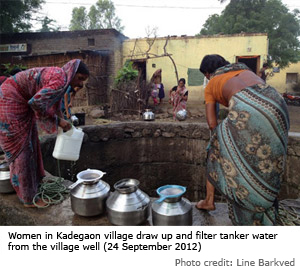
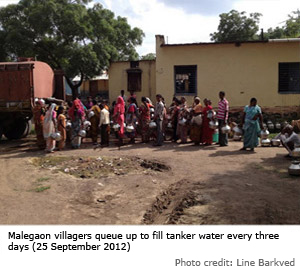 In Warudi village, 50-year-old Smt. Kaushalya Shinde hurried to fill the water the tanker had poured into the village well, before it got over by evening. In neighbouring Malegaon village, women queued up their vessels, two at a time, in anticipation of the tanker’s arrival. The tanker visited each habitation of the village only once every three days. In Kadegaon village, we caught up with a taciturn tanker driver, who made two-three daily trips from Somthana to Kadegaon. In this large village of several hundred households, the tanker full of water that he poured into the village well would get over in a few hours!
In Warudi village, 50-year-old Smt. Kaushalya Shinde hurried to fill the water the tanker had poured into the village well, before it got over by evening. In neighbouring Malegaon village, women queued up their vessels, two at a time, in anticipation of the tanker’s arrival. The tanker visited each habitation of the village only once every three days. In Kadegaon village, we caught up with a taciturn tanker driver, who made two-three daily trips from Somthana to Kadegaon. In this large village of several hundred households, the tanker full of water that he poured into the village well would get over in a few hours!
Is there so much water in Somthana? we asked him. The constraint, he replied, was not water, but electricity; load shedding in the summer kept a check on the water that could be extracted.
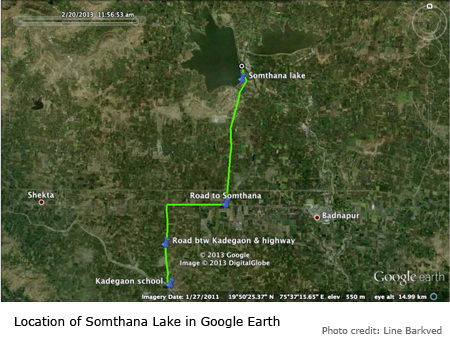 As we travelled from these villages towards the Jalna-Aurangabad highway, we saw the fields of Deogaon village, irrigated by canals from the Somthana reservoir. Water is usually released in January and February for the rabi wheat and jowar crops, which are irrigated two-three times a month. Irrigation was the original purpose for which a 2.75-km earthen dam had been constructed on the Dudhana River in 1964, creating the reservoir at Somthana.
As we travelled from these villages towards the Jalna-Aurangabad highway, we saw the fields of Deogaon village, irrigated by canals from the Somthana reservoir. Water is usually released in January and February for the rabi wheat and jowar crops, which are irrigated two-three times a month. Irrigation was the original purpose for which a 2.75-km earthen dam had been constructed on the Dudhana River in 1964, creating the reservoir at Somthana.
For more than a week, we ate lunch at the Mistri Dhaba on the highway, just across the arch showing the way to Somthana. We saw the tankers wait around and come and go, but with a full schedule of field activities, could not manage a trip to Somthana itself. Imagining a vast reservoir, we promised ourselves that we would visit when we returned to Jalna after five months.
When we did – the picture was somewhat different.
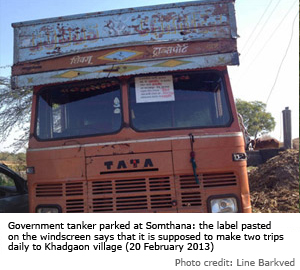 Our guide was Shri Kishore Gaikwad, whose family originally hailed from Somthana village, but moved to Kadegaon after they had to give up about 28 acres of land that was submerged when the Dudhana dam was constructed. An earnest, educated young man, Kishore is now employed as the Rozgar Sevak in Kadegaon, where he helps administer MNREGA work.
Our guide was Shri Kishore Gaikwad, whose family originally hailed from Somthana village, but moved to Kadegaon after they had to give up about 28 acres of land that was submerged when the Dudhana dam was constructed. An earnest, educated young man, Kishore is now employed as the Rozgar Sevak in Kadegaon, where he helps administer MNREGA work.
On our way, we stopped at a small home on the roadside, in front of which stood an idle tanker. The elderly couple we spoke with were agitated because the electricity connection to the area had been abruptly cut, so that water could not be pumped to fill tankers.
We next met Kishore’s cousin, who is the Deputy Sarpanch of Wahala, a village next to Somthana. It seemed that a dispute was raging over the precious well water in Somthana. While earlier in the season, tankers carted water all over the taluka from a seemingly bottomless source, now the shrinking supply of water was prompting local users to stake their claims. Farmers in Somthana, Wahala, and other neighbouring villages, wanted to continue using “their” water to irrigate their fields. If we don’t irrigate our crops, they said, what will we earn? What will we eat? But Somthana was also a crucial drinking water source for so many other villages in Badnapur taluka. Earlier that day, the District Collector of Jalna held a meeting in the area, but the dispute remained unresolved.
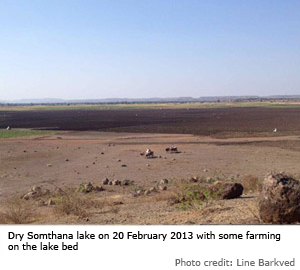
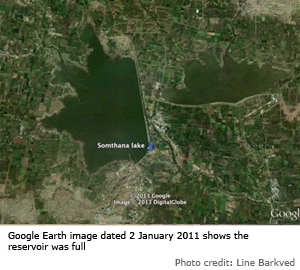 When we finally climbed up the earthen embankment of the tank, the vast reservoir designed to hold 15 billion litres of water, was empty.
When we finally climbed up the earthen embankment of the tank, the vast reservoir designed to hold 15 billion litres of water, was empty.
Spillway channels and a second overflow reservoir (built in 2011 in Davargaon) stretching into the distance, hinted at the majesty of the lake when it is full of water. In fact normally, 20–25 families together pay Rs 10–15 lakhs a year to the local Gram Panchayat for the right to carry out aquaculture in the lake. Instead, this year they were cultivating melons and legumes in the middle of the lake, where the last patches of moist soil remained.
The last time the tank had completely dried up was in 2004. But following years with less rain, as the lake starts shrinking in the dry season, people do start cultivating the moist fields that are exposed along the edges. Is this not adaptation? Is this not resilience?
So is this story of Somthana a cautionary tale? A tribute to human ingenuity? A reflection of the tradeoffs faced by “decision makers”?
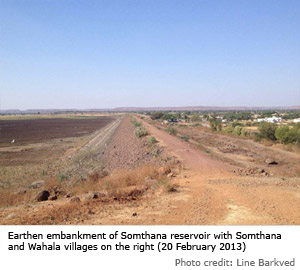
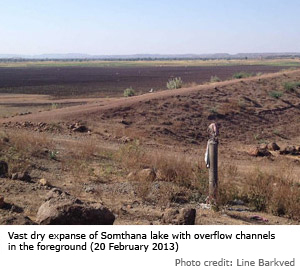 The question remains: if the rainfall in our country has an inherent variability, and climate change will bring more uncertainty, how can we prepare for extreme droughts like that of 2012? The solutions offered are usually neat, technical measures: farm ponds, drip irrigation, percolation tanks, larger reservoirs. But farmers themselves are quick to acknowledge that instead they indiscriminately dig ever deeper wells and run borewells “day and night”. So changes in technologies require changes in mindsets, changes in priorities require changes in policies. Or, as Siri Eriksen and her co-authors say in their 2011 paper , “Adaptation has often been operationalized in practice through changes in technology, institutions, and managerial systems…rather than challenging current development paths, including the social, economic, and political structures that underlie many contemporary problems.”
The question remains: if the rainfall in our country has an inherent variability, and climate change will bring more uncertainty, how can we prepare for extreme droughts like that of 2012? The solutions offered are usually neat, technical measures: farm ponds, drip irrigation, percolation tanks, larger reservoirs. But farmers themselves are quick to acknowledge that instead they indiscriminately dig ever deeper wells and run borewells “day and night”. So changes in technologies require changes in mindsets, changes in priorities require changes in policies. Or, as Siri Eriksen and her co-authors say in their 2011 paper , “Adaptation has often been operationalized in practice through changes in technology, institutions, and managerial systems…rather than challenging current development paths, including the social, economic, and political structures that underlie many contemporary problems.”
The example of Somthana offers a small glimpse of the complexity of the situation and the competing forces that drive the thirst for water.
The opinions expressed here are those of the individual authors. They do not necessarily reflect the opinions of TERI, CIENS, AFPRO, or the Norwegian Embassy.